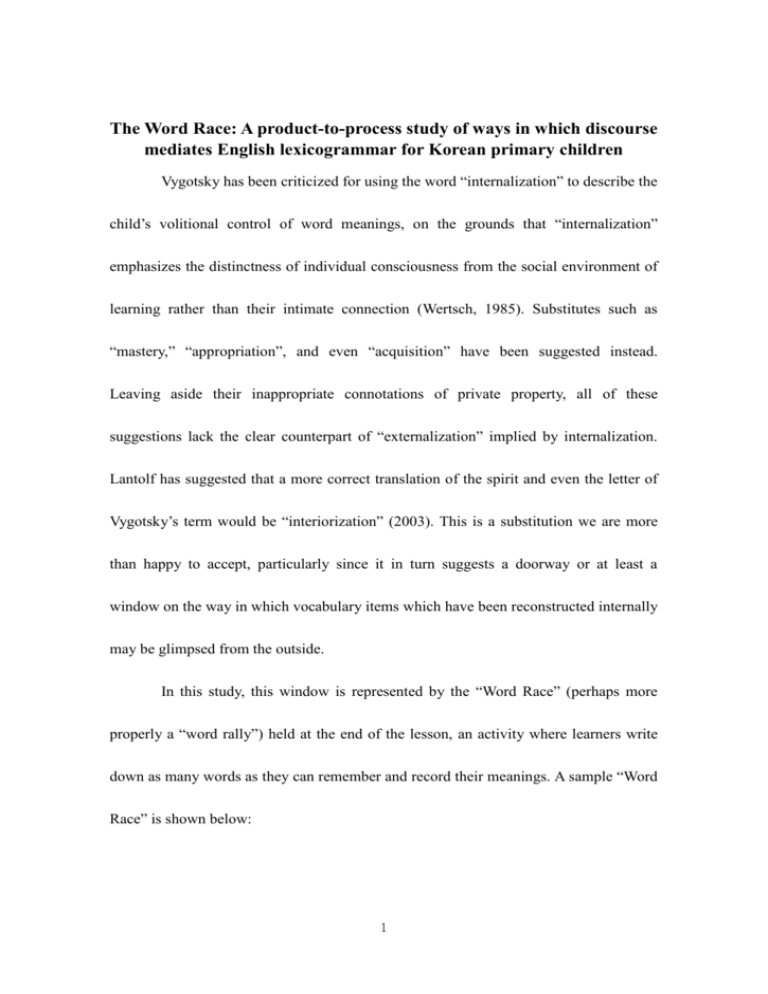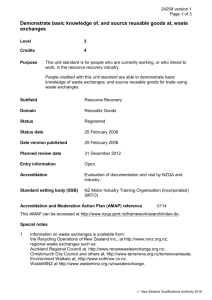less prospective more prospective
advertisement

The Word Race: A product-to-process study of ways in which discourse mediates English lexicogrammar for Korean primary children Vygotsky has been criticized for using the word “internalization” to describe the child’s volitional control of word meanings, on the grounds that “internalization” emphasizes the distinctness of individual consciousness from the social environment of learning rather than their intimate connection (Wertsch, 1985). Substitutes such as “mastery,” “appropriation”, and even “acquisition” have been suggested instead. Leaving aside their inappropriate connotations of private property, all of these suggestions lack the clear counterpart of “externalization” implied by internalization. Lantolf has suggested that a more correct translation of the spirit and even the letter of Vygotsky’s term would be “interiorization” (2003). This is a substitution we are more than happy to accept, particularly since it in turn suggests a doorway or at least a window on the way in which vocabulary items which have been reconstructed internally may be glimpsed from the outside. In this study, this window is represented by the “Word Race” (perhaps more properly a “word rally”) held at the end of the lesson, an activity where learners write down as many words as they can remember and record their meanings. A sample “Word Race” is shown below: 1 Figure 1 Sample “Word Race” by a Korean Fifth Grader The words remembered by the whole class (and also by individual students) can then be matched to one or more of the following mediational processes: Figure 2 Categories of Mediational Processes in the Data LESS PROSPECTIVE MORE PROSPECTIVE LESS VOLITIONAL MORE VOLITIONAL LESS Listen and Sing, speak or DECONTEXTListen and repeat answer the read along in Look and listen to UALIZED AND or read aloud after question on chorus with the the CD. (LLCD) LESS LEARNER the CD. (LRCD) the CD. CD. CONTROLLED (LACD) (SSRACCD) MORE DECONTEXTUALIZED AND MORE LEARNER CONTROLLED Look and listen to the teacher. (LLT) Listen and repeat or read aloud after a teacher initiate. (LRT) 2 Sing, speak, or Listen and read along in answer the chorus with the teacher in L1 teacher. or L2. (LAT) (SSRACT) EXAMPLES Look and Listen (T or CD). In the following “Look and Listen” exchange the teacher uses the CD ROM to present a whole unanalyzed dialogue: T: Look carefully. Daeum gwaro neomeogagi jeone han beonman deo deudgo, yeorobuni mandeun ‘future house’reul bolkeyo. (“Before we tackle the next lesson, we’ll listen to the dialogue again, and then we’ll look at the ‘future houses’ that you made.”) OK? Ss (do not respond) CD: (Conversation between Nami and Ann. Ann is introducing her house to Nami.) Ann: This is my house. Nami: Wow! It’s great. Ann: Thanks. This is my living room. SS (do not respond) LISTEN AND REPEAT (T or CD) In contrast, the use of “Listen and Repeat” analyzes the dialogue into individual utterances. The teacher makes sure that this is not simply a phonological exercise by providing “Look and Listen” explanations linking gestures and Korean word meanings: 3 CD: I went to the science museum yesterday. Ss: I went to the science museum yesterday. CD: Science museum? Ss (looking at teacher who gestures upwards to indicate the intonation): Science museum? T (breaking into a “Look and Listen” explanation): Wae ireoke mueobwa? Ah, “Science Museum” gassdago? Geureon deusijyo? (“Why does he ask like that? Ah, you say you went to the ‘Science Museum’? That’s what he means, isn’t it?”) CD: What did you see there? Ss: What did you see there? T (once again breaking into a “Look and Listen” explanation): What did you see there? Museun ddus? Geogiseo mueol bwasseossni? (“What does it mean? What did you see there?”) LISTEN AND ANSWER: In “Listen and Answer”, the teacher sometimes is not able to analyze the utterances further because she simply asks for translations, as here: 4 T: What did you do yesterday? Museun malilkka? (“What is he saying?”) Ss (translating): Eoje mueohessni? (“What did you do yesterday?”) Of course, the use of English does not always force the children to analyze: CD: Where is the bathroom? T (alongside the CD) Where is the bathroom? Ss (answering the question): Let’s see…/wait…. And when LA interactions do analyze the utterances along the lines of question/answer, the result is often an unstructured group of nouns much criticized by Mishler (1972: 278-279). T: Who is it? Ss: Jinho. T: Jinho… Yes. Jinho, and…? Ss: Michael/John. T: Michael? No… Michael is like a… black reggae boy. 5 Ss: Bill. T: Yes, he’s Bill. Jinho and Bill. Now, what else do you see? Ss: Soccer ball. T: Soccer ball. Yes. Ss: Science book. Book. T: Yes, yes. Science book. SPEAK ALONG: In “Speak Along” exchanges, we often see the individual units resynthesized into phrases, utterances, and even, in the case of songs, whole dialogues. Here the teacher prompts the children to supply a phrase in simultaneous chorus: T: Jinho is… (gestures for running and kicking) T and Ss in chorus: RUNNING AND KICKING! WORDS, LEARNERS, AND EXCHANGES WORD PROPERTIES 6 When we looked at the results from the point of view of the nature of the words themselves, they are, at first glance, stunningly predictable. Forty-five of the 50 wellremembered words were concrete words like “kick”, while 20 out of the 50 poorlyremembered items were more abstract words like “excellent” or functors like “will”. Forty-nine of the top fifty were words of everyday life such as “play” rather than unusual words like “honorarium” (30 of the bottom 50). There are, nevertheless, some surprises. In the lesson of December 5th 2005, for example, "snow" and "carrot" appeared only twice and once respectively in video exchanges, but "snow" was ranked as the second best remembered word (after “snowman”), and “carrot” was also in the top five best-remembered words. On December 3rd and 4th, more than seven centimeters of snow had fallen on the city of Seoul, the heaviest snowfall of the year, and this was discussed in pre-class chat and episodically throughout the lesson. T: On Sunday morning, On Sunday morning how was the weather? Ss: snow…snowy T: It was snowy. Ss (in chorus): Snowy! 7 S1: Very very. During the lesson, the teacher put up a visual image of a snowman with onions for eyes, a potato for a nose, and a carrot mouth. She made the mistake of leaving this on the computer monitor during the Word Race activity. Because there was this visual prompt immediately in the environment, and because there was snow clearly visible outside the window, we cannot really say these words are fully interiorized! We certainly cannot say that the interiorization of “snow” and “carrot” is all thanks to their concreteness; it cannot be separated from the serendipitous mediational classroom processes involved. INDIVIDUAL LEARNERS Nor can it be separated from the individual learners involved. Although 48 out of the 50 well-remembered words were single words, while 10 out of the 50 poorlyremembered words were multi-word fixed phrases, a small number of learners appeared to have trouble analyzing utterances into word meanings. GS (not, of course, his real name) is one such student. Here the teacher is asking him to read from a list of individual words having to do with eating (“knife”, “fork”, “spoon”, etc.), at the end of which are a few phrases such as “Help yourself” and “No, thanks”. Counterintuitively, 8 he begins the list at the end. T (using the polite register of Korean): Ilgeoboseyo. (“Please read.”) Ready, go. GS: (Silence) T (switching to the intimate register): Aneun geotman golaseo ilgeobwa. (“Just try and read the stuff you know.”) GS (reading a whole phrase at the bottom of the page): ‘No thanks.’ T (using an intermediate register): Johayo. (“Very good.”) GS: (Long silence) T (switching to English): Anything else? GS: (Long silence) T: OK. Two days later, the following “Listen and Answer” exchange is used to illustrate “running”. T: (Drawing a boy) Who is it? Guess. Ss: GS. 9 T: Yes, GS. GS‘s hair style. T: GS is~? Mueo haeyo, jigeum? (“What’s he doing, now?”) Ss: running. GS is running Apparently, GS is able to use this fleeting exchange, in which he does not even take part, to analyze the sentence “I’m running” in his Word Race (his Hangeul script is Romanized and translated in parentheses here): Figure 3 “Word Race” Results for GS Running Jigeum, dduigoissda (Now, I’m running) I'm running Naneun jigeum dduigoissda. (Me + Korean topic marker, now, I’m running.) I'm Naneun. marker) (Me + Korean topic Even the expression “jigeum” (“now”) is used in his analysis, which although it does not perfectly correspond to a breakdown into English words, is nevertheless quite far from his previous holistic approach. This is not, of course, the path that other peers took to analyzing this particular piece of discourse into lexicogrammar; it is dependent, among other things, on the teacher’s knowledge of GS’s name. 10 Figure 4 Correlations of Exchange Categories with “Word Race” Results Sing/Read Look Listen Sing/Read Listen Type of and / Look at Listen and Listen and and /Speak and Speak and Listen Repeat Answer Exchange Listen Repeat Along Answer Along to the After the the (Number of to the after the with the the CD Exchanges) CD Teacher Teacher Teacher CD Teacher (3) (57) with the CD (76) (104) (220) (82) (16) (26) Pearson Correlation .143 .334(**) .037 .153 .468(**) .428(**) .292(*) .344(**) .238 .762 .210 .000 .000 .014 .004 Coefficient Level of .005 Significance ** significant at the level of p < 0.01 (two tailed). * significant at the level of p < 0.05 (two tailed). The Listen and Answer the Teacher (LAT) exchanges were the most frequent, yet these predict Word Race results only weakly, while the Look and Listen exchanges with the teacher correlate very strongly, although they are not frequent (only 76). This can 11 probably be explained by the circumstance that almost all the words in the Look and Listen exchanges were then taken up by the teacher in Listen and Answer exchanges, but not all the words in teacher-led Listen and Answer exchanges were introduced in Look and Listen exchanges. This means that words in Look and Listen exchanges received more different types of mediation, even if Listen and Answer exchanges were more frequent. Only the 82 Listen and Repeat exchanges initiated with the CD ROM predicted the Word Race results with any degree of significance. Doubtless part of the problem was frequency (there were only 3 CD ROM initiated “Listen and Answer” turns) but this is not the whole story, for there were 57 Look and Listen to the CD exchanges, and these failed to correlate significantly our results. In contrast, all categories of exchange initiated by the teacher achieved significance, and all but one were greater than CDROM initiated “Listen and Repeat.” One way to account for the apparently greater efficacy of teacher-led exchanges is simply to refer to the anecdotal evidence we cited previously; unlike the CD-ROM, the teacher is able to edit the material to include immediate context such as the current snowy weather and GS’s name, and of course the teacher is also in a better position to slow down, speed up, and repeat at will. 12 However, what we wish to present here is not an invidious comparison of noninteractive CD ROM technology and a warmly responsive flesh-and-blood teacher but rather a whole model of linked classroom processes. Our teacher has her weaknesses too. In one lesson, two of the words which appeared most frequently in the teacher led exchanges and yet least frequently in the “Word Race” results were “want” and the preposition-article combination “in the”. “Want” was in fact one of the teaching goals of the day and appeared in 41 exchanges and all eight categories of exchange, but neither the teacher nor the CD uses it as an independent word. Indeed, the most common use of “want” is in LR/LA exchanges like these, which offer no productive role at all to the children. CD: Do you want a fork? Ss: Do you want a fork? T: Do you want a fork? Ss: Do you want a fork?/ Po-keu, po-keu (“Fork, fork.”) T: (Pretending to give a fork with hand gesture) Neo…po-keu want? (Korean SOV word order: “You…fork ‘want’?”) Ss: 줄까? Jul-kka? (“Shall I give you one?”) 13 Here the teacher comes closer than the CD to isolating “want” as a word, but when the children offer a translation which merely reflects the whole pragmatic situation and does not analyze the utterance lexicogrammatically, the teacher accepts it. “Want” remains unlearned as an item, and is grossly underrepresented in the Word Race results. The case of “in the” offers a direct contrast: here we have an item which is not intended to be isolated, but which one learner does analyze as a single unit. How did this happen? The lesson video contains the following LA exchange: T: Where's the baby? Where's the baby? S: Madang (“Yard.”)/ Backyard. / In the back yard. T: Backyard. Eodi Eodi ane issda…neun? (“Where, where is it?”) S: Baby in the backyard? / in the? It appears that some of the children have decided that “in the” is the correct answer. Unfortunately, the rest of the discourse does not obviously dispel this possibility. T: In the…backyard. In the backyard. OK? Let's see... Where's the baby? 14 S: In the backyard. T: In the? S: Backyard. Near the end of the semester we asked the children to record any and all the words they remembered from the whole semester, and perhaps inevitably, the long term results were much more diverse than those found lesson by lesson. Although in all 261 different words were recalled, below the 69th rank, only three or fewer children correctly recalled the word, and below the 83rd rank there were two or fewer. Below the 132nd rank there was only one 1. All except six were single words, not multi-word phrases. There were only 19 functors ("you", "he ", "is", "she", "me", "mine", "are", "on", "under", "can", "did", "I", "in", "-ing", "it" ,"they", "we", "a", "am"). "You" ranked 13th, but all the other functors were below 70th in rank. Remembered words were mostly nouns and verbs with rather concrete meanings, all of which appeared in the list of best remembered words in our word race. Interestingly, the top 5 words were numbers, perhaps because of the short-term effect of the last lesson which was about the game for phone numbers. Thus we see that in terms of word properties and learners the long-term results were similar to the lesson-by-lesson results. 15







